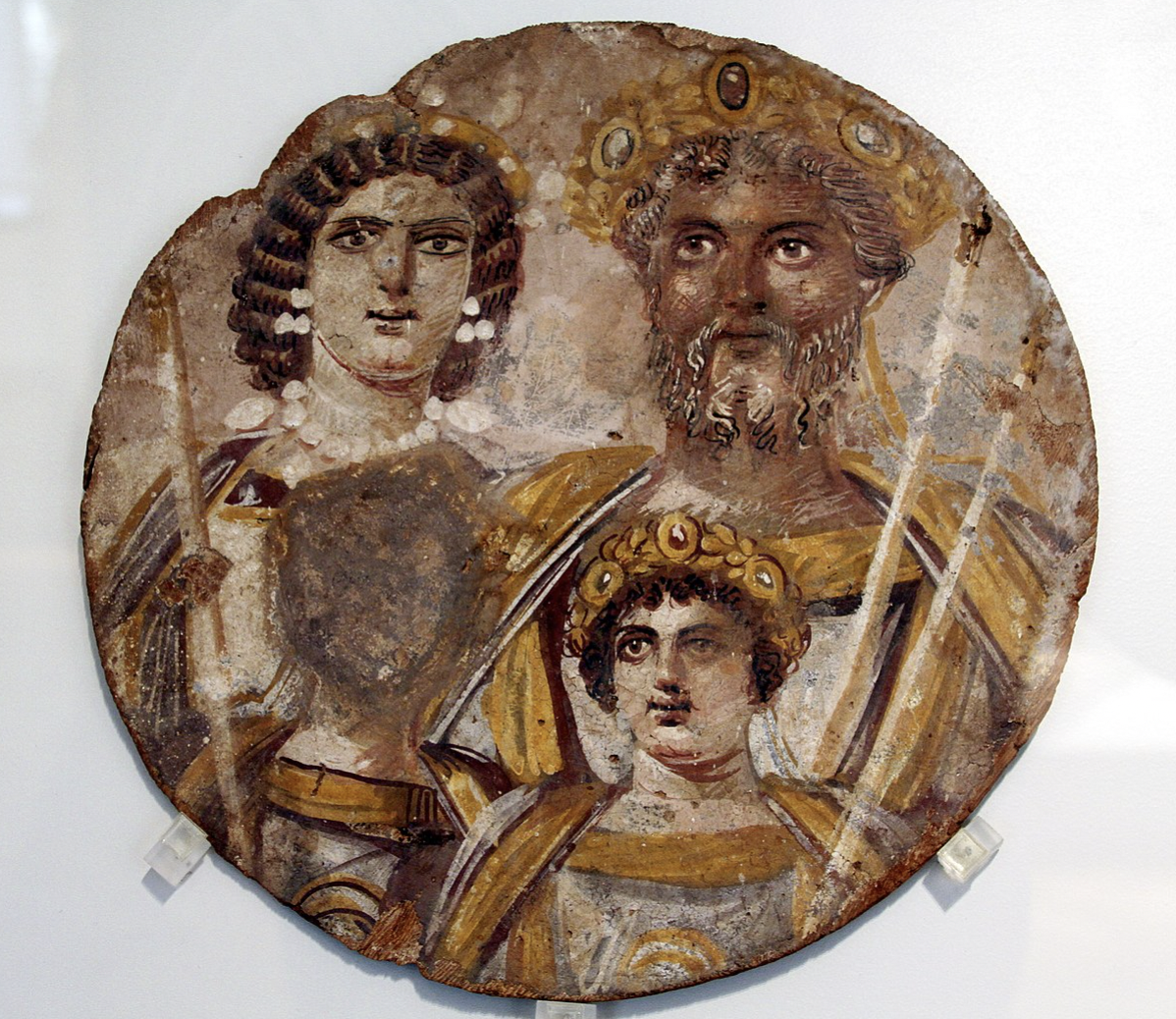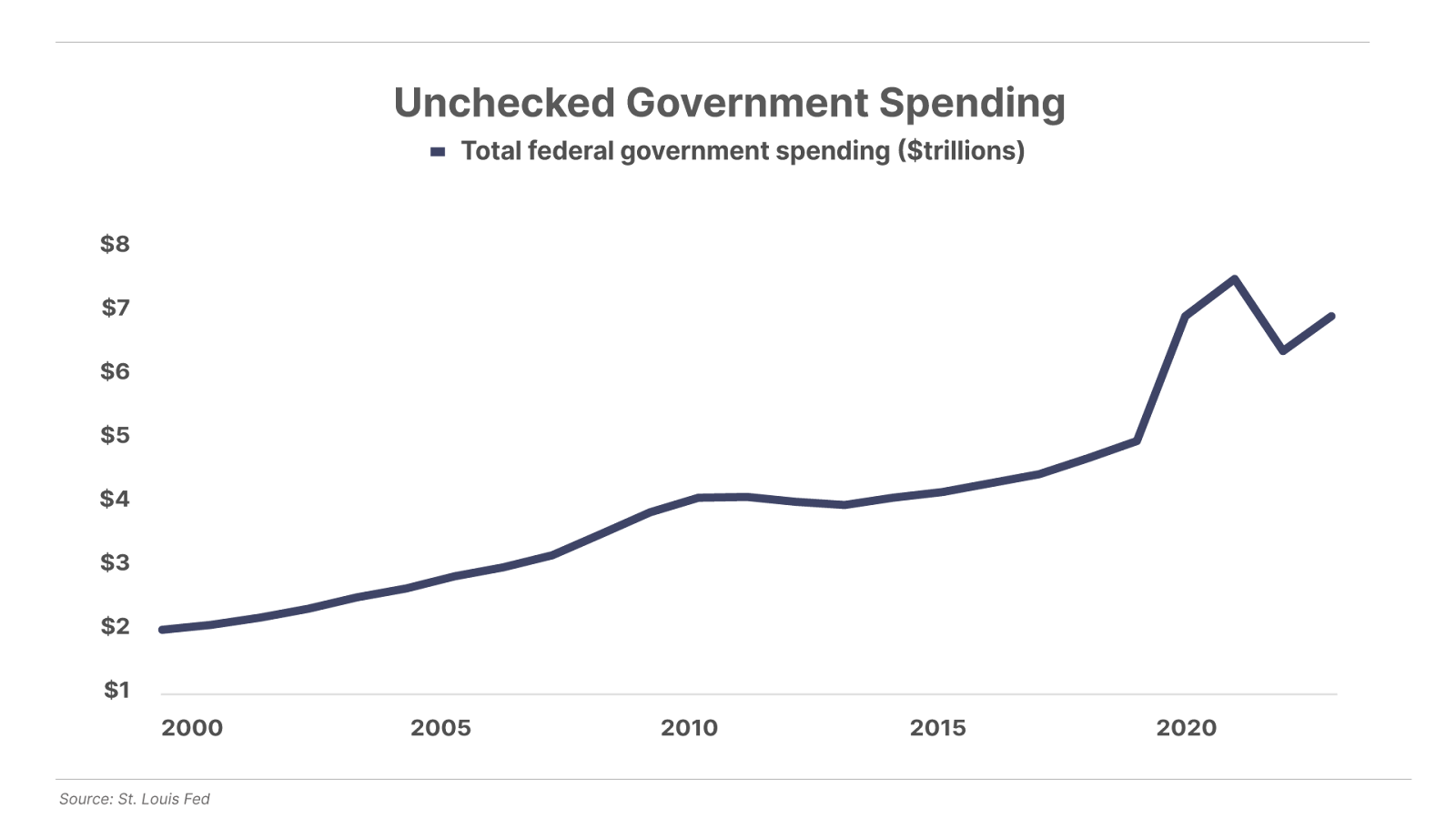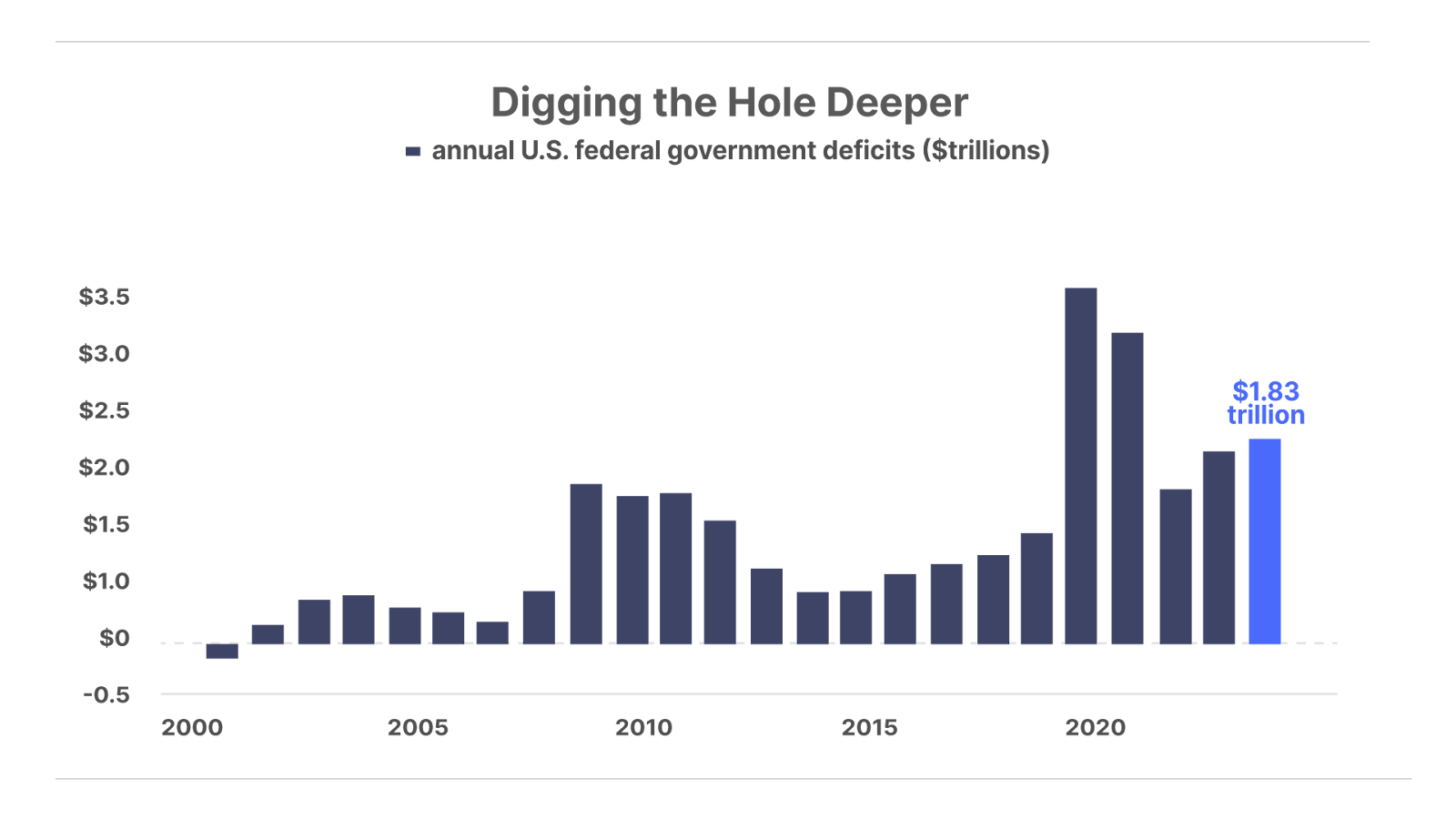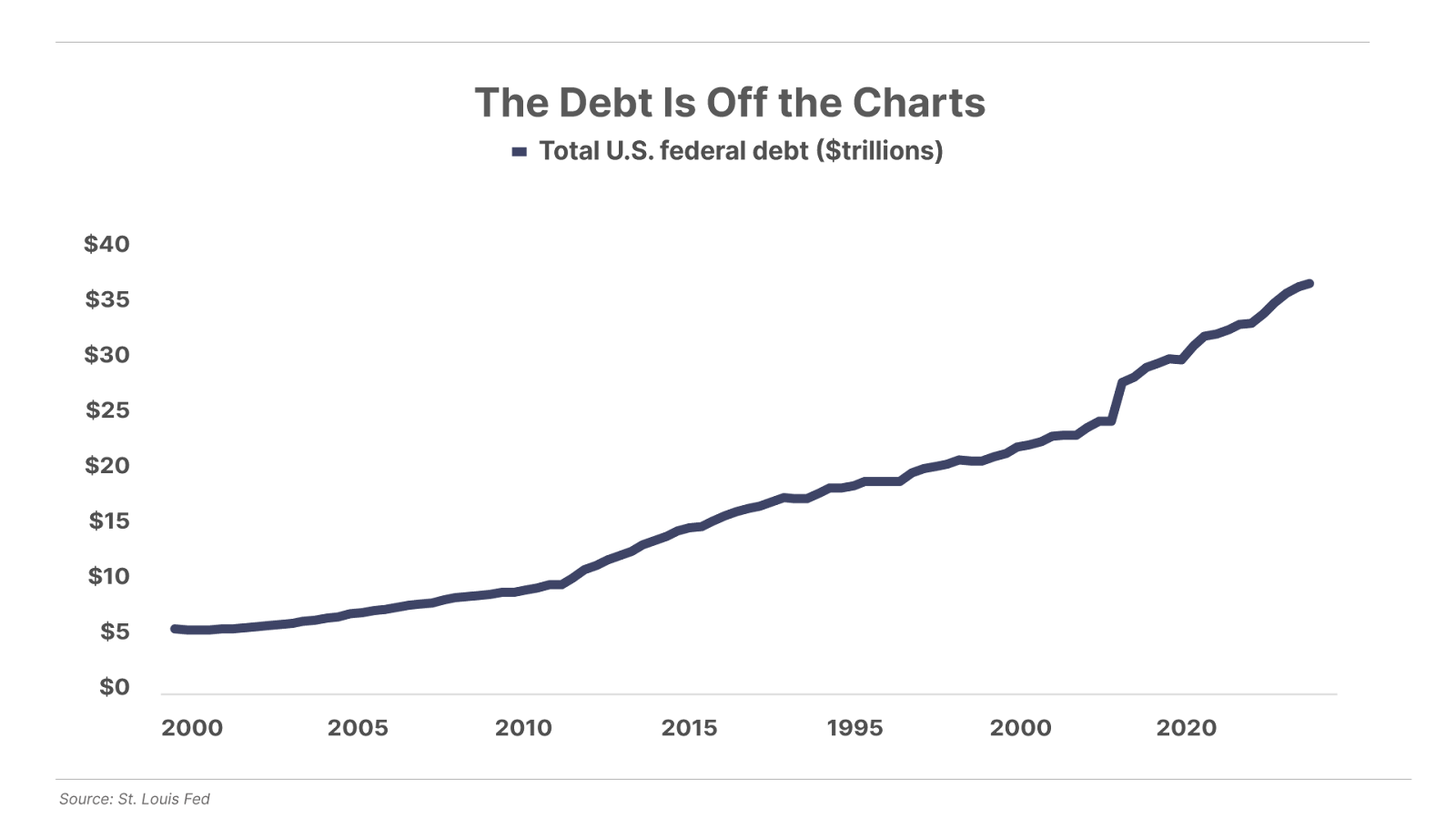
Clipping Coins, the Trillion-Dollar Way
And It Will Only Get Worse After November 5
Septimius Severus’s last wish was that his two boys would get along.
The handsomely bearded Roman emperor – fading fast on his deathbed in February 211 AD – left his sons Caracalla and Geta, co-heirs to the throne, with this impassioned plea: “Be good to each other, enrich the army, and damn the rest.”
The pair of “Irish twins” – born just 11 months apart – glared at each other across the bed. The first part of Severus’s advice would go unheeded.
The young men had been rivals all their lives, and being co-emperors just fueled the feud. Before long the brothers were camped out in opposite ends of the imperial palace, periodically sending servants with poisons to slip into the other’s food.
Then – the final straw – Geta, the younger brother, grew an impressive beard…
Geta was now the spitting image of his well-loved father, and the boy’s popularity skyrocketed among the Roman citizens and the influential 450,000-man military. Caracalla (shorter than Geta, and with less facial hair) saw a coup in the near future… so he decided to strike first.
During a diplomatic meeting later that year, he leaped at Geta and stabbed him to death. Not content with killing his rival, he also canceled the annual horse races held on Geta’s birthday, and scratched his brother’s face out of all the family portraits.

Caracalla now had sole possession of the throne, but he also had a problem: the military. The legionnaires weren’t happy about Geta’s death… and they were well armed with one sword and two javelins per soldier. Just in time, Caracalla remembered the second part of his father’s advice: “Enrich the army.”
To do so, the new emperor decreed a hefty pay raise – a 50% increase annually for every soldier, plus a generous bonus of 2,500 denarii (one denarius equaled roughly a day’s wage) for each officer. The army’s protestations quickly subsided, they decided to support Caracalla, and from then on, he was free to reign unchallenged as God-Emperor.
All that money had to come from somewhere, though… and a lack of understanding of the economics of that turned out to be Caracalla’s downfall.
The Secret Tax
In order to scrounge up cash to “enrich the army,” Caracalla reached for an easy fix: debasing the Roman currency via “coin clipping.” This process involved rounding up existing coins and re-minting them into new ones with less precious metals content. The less silver in the coins, the more coins he could mint, and the more “money” he’d have to buy support from the soldiers and officers.
Like all inflation schemes, it worked for a little while… until it didn’t.
Caracalla didn’t invent currency debasement. His father had done the same thing: drastically reducing the silver content in the denarius to fund periodic raises for soldiers (and welfare programs like grain subsidies). So had several other earlier emperors. The trend had started back in 60 AD with the infamous Nero, who’d diluted the denarius by 10% to finance his lavish orgies.
Caracalla, though, took debasement to a new level. He invented an entirely new fiat coin: the double denarius. It was supposed to be worth two denarii… but, cut with base metal, it only contained about 1.5 denarius’ worth of silver. The double denarius soon became the standard coin of the land. The silver content continued to be reduced as the Empire increased its military spending: by the end of Caracalla’s reign in 217, Roman coins contained just 50% silver, down from 58% when he started… and down from 75% just 20 years earlier
Why not just tax the populace to get more money? Politics, of course. The Emperor needed a “good cop” façade…
Aside from an ill-fated experiment during the late 1st century BC – when the government hired increasingly corrupt “tax farmers” who’d collect taxes for the Emperor while padding their own pockets – for the most part, Roman taxes remained relatively low and reasonable, at flat per-capita rates ranging from 1% to 5%. Excessive taxation leads to civic unrest, and the increasingly disorderly Roman Empire couldn’t afford any more unrest.
Currency debasement, though, is in effect a secret tax. The public doesn’t know they’re paying it… or often, have any way to measure how drastic it is… which means the government can get away with a lot more of it. Until it can’t.
As economist John Maynard Keynes wrote in his 1919 book The Economic Consequences of the Peace:
By a continued process of inflation, governments can confiscate, secretly and unobserved, an important part of the wealth of their citizens. By this method, they not only confiscate, but they confiscate arbitrarily; and, while the process impoverishes many, it actually enriches some.
As Septimius Severus said: “Enrich the army, and damn the rest.”
Post-Caracalla, the ratio of silver in Rome’s money kept declining… and Rome itself slid straight to irrelevance…
By the time of Emperor Claudius II in 269 AD, the country was flooded with worthless double denarii, containing about 2% silver – just enough to cover the coin’s bronze core. Citizens were unable to pay taxes at all and the government forcibly seized tributes in the form of land and goods. During the Imperial Crisis – from 235 to 284 – 20 emperors rose and fell during a period of riots and mass civil unrest. Eventually, when the barbarians invaded in 455, many impoverished Roman citizens welcomed them.
Today, we’re rapidly approaching a similar inflection point. Our money is losing value by the day. Inflation is a secret tax – and we are about to be taxed to death. The barbarians will soon be at our gates.
The Issue Neither Candidate Is Talking About
Next week, Americans will head to the polls to vote in what The New York Times has called “the most important election since 1860.”
The reality is America is barrelling toward a crisis. And both former President Donald Trump and Vice President Kamala Harris are likely to make it even worse.
As in ancient Rome, it’s uncontrolled spending that is leading us into trouble.
As you can see below, annual U.S. government spending has more than tripled since 2000.

As spending has soared, deficits have skyrocketed, from a small budget surplus in 2000 to an annual deficit of nearly $2 trillion today.

Soaring deficits have naturally caused federal debt levels to explode higher, from around $6 trillion in 2000 to nearly $36 trillion today.

The rise in both spending and debt over the past 25 years has been relentless. But the upcoming election could cause this trend to accelerate even faster.
Trump or Harris: More Spending Is All But Guaranteed
There are, of course, many policy differences between Trump and Harris. But the two candidates are remarkably similar in one critical way: Both are proposing further dramatic increases to government spending.
According to The Wall Street Journal, Trump’s plan – which includes tariffs, increased border security, military expansion, and tax cuts – will cost an additional $7.5 trillion over the next four years. Harris’ plan – which includes tax hikes and new spending programs – is estimated to cost slightly less, but still a staggering $4 trillion in new spending over the same period.
However, these figures are in addition to the ongoing growth in legally mandated spending on entitlement programs like Social Security and Medicare, spending that is on track to grow by more than $20 trillion over the next decade.
This combination means the government will rack up another $30 trillion in new debt over the next decade regardless of which candidate wins next week.
This would nearly double the total amount of debt the government owes to $60 trillion. Measured against the size of our economy, this would push our debt burden well beyond all previous records, including those of the Civil War and World War II.
It’s worth noting that Trump has said he would, if elected, task Tesla (TSLA) CEO Elon Musk to lead an effort, dubbed the “Department of Government Efficiency,” to cut wasteful government spending. And Musk – despite having no experience in government or how it works or how funds are allocated and spent – says that he thinks he could cut $2 trillion in spending, or almost one-third of the current federal budget.
Cutting that much from the budget (without increasing spending anywhere else) would go a long way toward balancing the budget. But it would almost certainly require making cuts to entitlements and defense spending – which together account for two-thirds of government spending – and would likely require Congressional approval.
Barring cuts to these programs – which are not politically palatable – there’s little chance of preventing the deficit from continuing to escalate. No other items alone are large enough to move the needle.
Even if the Treasury was able to significantly reduce its interest expense through some combination of Federal Reserve rate cuts and yield-curve control, the government would likely still run deficits of $1 trillion per year for the foreseeable future.
The bottom line is that this spending – like all government spending – will ultimately be paid for either through direct taxation, or more likely, the “secret tax” of inflation. Of course, the U.S. government no longer needs to clip coins to debase the currency. In our modern fiat monetary system, creating more dollars is as easy as clicking a few buttons on a computer keyboard.
The Tax That Kills The Middle Class
But as in ancient Rome, it will be ordinary people who foot the bill.
Paper money is devastating to the middle class. It destroys the buying power of the wages they earn. That’s extremely dangerous for civil society. It creates the very real impression in the general population that the economy (and therefore the government that controls it) is illegitimate.
This is why paper money and major periods of inflation always presage the most violent forms of populism and revolution – from the witch trials, to the rise of the Nazis, to the storming of the U.S. Capitol in 2021
Perhaps the bigger problem, however, is that paper money is an enormous subsidy for the state. It sets the stage for virtually unlimited government budgets, as we’re seeing today. That encourages people to use the government in all kinds of ways that are extremely destructive for civil society – like starting wars, whether that’s raiding Quebec, or invading Iraq, or (unintentionally or otherwise) failing to stem steadily escalating conflicts in Ukraine or the Middle East.
Paper money and the lack of any fundamental limit to credit and money, also leads to unrealistic projects to reorder our domestic society – because no social benefit is unaffordable. The “war on poverty” and the “war on drugs” were both launched as the U.S. switched to a pure paper currency in the 1970s, from the gold standard.
And just like in ancient Rome, there will be winners and losers. One of the ways to ensure that you aren’t a loser is to focus on assets that preserve wealth over time. Gold, of course, is one answer… as Porter and world-class gold expert Marin Katusa discussed during a recent conversation. Gold has been on an historic run – but as Marin explains, gold shares haven’t even begun to catch up. Learn more by watching their conversation here.
Porter & Co.
Stevenson, MD
P.S. They’re some of the best-performing assets of recent years: Bitcoin, AMD, and Nvidia.
Getting in early on just one of these companies years ago would forever transform your wealth.
And that’s what my friend Jeff Brown did: He recommended each of these to his readers well before anyone was talking about them
What’s happened?
Since 2015 – when Jeff recommended it – Bitcoin is up 26,613%.
Nvidia… recommended in 2016, up 10,422%.
And AMD is up 1,229% since 2017.
In addition to being a fantastic stock picker – one of the best I’ve ever worked with – Jeff is an absolute prophet when it comes to anticipating the direction that technology is moving in.
He has a deep, intuitive understanding of new technologies, and an unparalleled ability to pick the winners of these emergent trends.
In Tuesday’s Porter & Co. Spotlight, Jeff shared his report on a company he says “could become the market’s next AI darling.”
As always for our Spotlights, this is research that’s typically only available to Jeff Brown’s paying subscribers, but is free for the Porter & Co. family… Check it out here.
And if you want to find out more about Jeff’s research (at a substantial discount to his normal prices) and get his future recommendations, go here now.